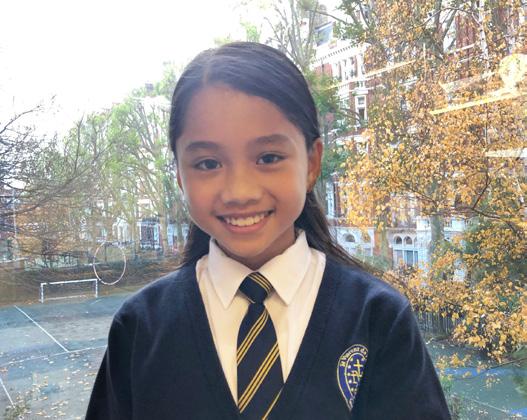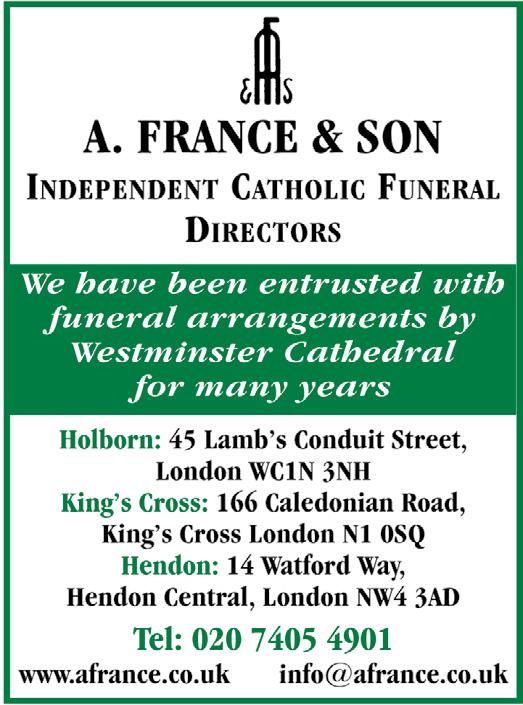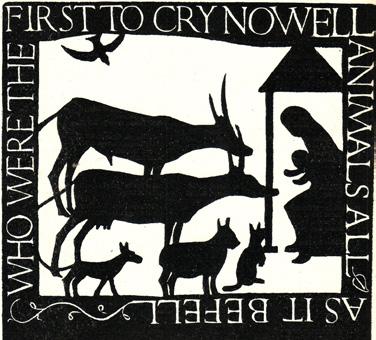
8 minute read
Cathedral History in Pictures – Bishop Butler opens the Cathedral Piazza by Paul Tobin
Paul Tobin
Weeks after the funeral of John Carmel Cardinal Heenan, the official opening of the piazza was carried out by Bishop Christopher Butler OSB in his capacity as Vicar Capitular of the diocese during the interregnum until the appointment of the next archbishop (Abbot Basil Hume OSB) in February 1976.
Redevelopment of this area of Victoria Street started in 1959 with the closure and subsequent demolition of the Stag Brewery opposite the Cathedral on the site where Cardinal Place now stands. Hidden from view in Victoria Street by large buildings used mainly for offices, access to the Cathedral was only available through Ashley Place. Opposite the Cathedral were three retail outlets, one of which was the Art and Book shop, run by Anthony Bartlett, brother of the former Cathedral Administrator, Mgr Canon Francis Bartlett and Gentiluomo to four archbishops. This shop dealt with religious artefacts, antiques and church furniture. The other two outlets were Burns & Oates and the Catholic Truth Society bookshops. These were all demolished as part of the development of the area.
In the picture, Bishop Butler can be seen under the canopy on the right with a commemorative plaque (since removed) to the left of the canopy. Readers will notice how the piazza has changed in the 45 years since its opening; the raised flowerbeds have gone and more importantly, Disability Discrimination legislation meant that access to the Cathedral needed to be improved. In 2010, therefore, ‘a new arrangement was made, the step line being brought forward in a sweeping curve to accommodate ramped access to either side behind the new step’.1
The space in front of the Cathedral has drawn many people to the building who otherwise may not have known of its existence, due to it being hidden by the tall buildings of Victoria Street. It has also allowed large crowds to assemble in front of the Cathedral, most memorably in 1982 on the occasion of the visit of Pope St John Paul ll and subsequently a decade ago in 2010 with the visit of Pope Emeritus Benedict XVl. Most recently it has accommodated the queues of the faithful who have gathered waiting patiently for the main doors to be opened before Sunday Masses in particular during the months of restricted opening hours due to the coronavirus-imposed cleaning schedules in the Cathedral.
Acknowledgments:
1. St Ann’s Gate Architects LLP, The Close Salisbury,
SP1 2EB (2012) Image: Post Card IM/L&T/976- Cathedral Archives.
Virtual School and Real School
Jhennielle (Year 6)
During this pandemic, we have missed many school activities we had been looking forward to, but it is imperative that we still keep soldiering on with our education at school and at home. As a daughter of key workers, I was able to come to school during the first lockdown. I was put in a class of ten pupils with a mixture of different aged pupils, which meant I did not have the opportunity to see all my friends from my year group. We were lucky enough to have a Mass which was conducted by Cardinal Vincent via zoom at Westminster Cathedral.
While at home last week during virtual school, we participated in class meetings on Google Classrooms to keep up with our learning. At the beginning of our session, we would start the day with a morning prayer and reflection. The whole class, along with the teacher, would pray together and we could all observe each other doing so. This would also take place when we started our afternoon session. These sessions reminded us that, rather than being at home, we were all together in a classroom setting and we should behave accordingly.
In one of our online Religious Education lessons, we talked about vocations and how people with different vocations influence our own lives; this led us on to our school mission statement ‘Love one another as I have loved you’ and the commitments we make when fulfilling it. We discussed about the priesthood and the serious commitments priests make just so that they can be closer to God. The lesson also included people in our own lives who inspire us. For me that person is my mother. She is a nursing assistant who works for the NHS, so not only does she helps my siblings and me but also people she comes across in her job every day. These lessons
allowed us to see one another and to participate in the conversation by raising our hand and waiting patiently to take our turn to add our thoughts to the discussion.
Now that we are back in school, we are focusing on our new topic, Judaism, a religion that started around 4,000 years ago in Israel now with over 12 million followers. In these lessons, we have been learning about Rosh Hashanah, the Jewish New Year that usually takes place in autumn. This event lasts for ten days. They eat apples with honey, which represents a sweet new year and have special bread called challah that is shaped round to symbolize eternal life. The last two days of Rosh Hashanah are called Yom Kippur and those two days are for fasting and holy services. I find it interesting learning about other faiths.

If someone were to ask me what I preferred when comparing virtual learning at home to actually being in school, I would have no hesitation in choosing being at school and taking part in everything that school life has to offer, which includes spending time with my school
family.

In retrospect:
from the Cathedral Chronicle
Varia
As the authorities this year decided not to repeat the dramatic announcement by means of maroons of Armistice Hour on November 11, the two minutes of silence for special remembrance of our fallen warriors was not as outwardly effective as last year. Nevertheless, the absence of the arresting, and, for some, rather nerve-racking reminder by maroons afforded evidence of something more deep and impressive. Victoria is a busy place, indeed, yet it was obvious that people in this crowded neighbourhood of converging traffic were alertly mindful of the eleventh hour, and punctually to the minute by the clock to be seen at the Vauxhall Bridge Road terminus, silence and stillness fell with a rapidity that came as a surprise to those less heedful of the hour. Surely the result of this ‘holy and wholesome thought’ of our dead warriors is unmeasured in its good influence. This brief great silence at Armistice Hour is in principle in unconscious agreement with Catholic doctrine ‘to pray for the dead that they may be loosed from their sins’. For is it fond memory only that fills these two great minutes of silence and sends the nation in a might pilgrimage to the Cenotaph – that gaunt symbol before which now stands banked high a maze of flowers and wreaths? Is no prayer uttered by those vast crowds who pass it with bared heads? Empty sentiment may move some, but we prefer to think that amongst the majority much ‘holy and wholesome thought’ centres round the Cenotaph and finds its outlet in prayer for the dead. Would that the full Catholic teaching on this and other doctrines might lead them in the way of peace!
This is the frontispiece of the December 1920 Westminster Cathedral Chronicle

The renewed effort made by a Sunday paper of the Northcliffe Press to increase its circulation by again widely advertising the publication of further spiritualistic ‘revelations’ by Mr Vale Owen fills us with shame and disgust. That this appalling nonsense should be put into print at all is astounding enough, but that such spiritualistic drivel should be made, with blatant acclamation, the means of vaunted increase of circulation is a desecration even of modern journalism. from the December 1920 Westminster Cathedral Chronicle
The Christmas Message of Cardinal Heenan If anything were needed to put the Catholics of England into a festive mood for Christmas the canonisation of the Forty Martyrs [which had been celebrated in Rome on 25 October 1970 – Ed.] supplied it. We no longer shout with joy when we want to express publicly our gratitude for the faith. We have been schooled in recent years against saying or doing anything that could be interpreted as triumphalism. This puritan diet to which we have rigorously adhered since the Council was beginning to undermine our spiritual stamina. We had almost begun to think it sinful to take pride in our Church. Then came the canonisation to remind us that Catholics should be jolly and courageous, holy and loyal. The Martyrs died cheerfully – some with a joke on their lips while standing by the gallows – but literally in deadly earnest when protesting that they would rather die than betray the Catholic religion. So the Martyrs have set us in right mood for Christmas. These men and women, despite bitter persecution, never hated their tormentors. They genuinely loved their fellow countrymen and wished them well. When they prayed for their Queen, their judges and even their executioners they were not cynics scoring a point nor defeated soldiers firing a Parthian shot. Their outlook was quite uncomplicated. They loved their faith and they loved their country. Whether their fellow citizens were Catholics or Protestants was God’s affair. He alone gives faith. The Martyrs did not judge or condemn. Enough for them to know they must be ready to take up the cross. They preached by their example more often than by their words. The priests among them like St Edmund Campion did, of course, also give eloquent testimony by word. But most of them were content just to lead zealous Catholic lives. They loved the Mass and Our Lady. They were a contented band. The grace to imitate them is the most suitable gift for which to pray this Christmas of the canonisation. The return gift we make to the Child for His birthday is the same each year. We offer Him ourselves. He does not laugh at us and throw back our useless gift in our faces. That is the measure of the mystery of God’s love. from the December 1970 Westminster Cathedral News Sheet






